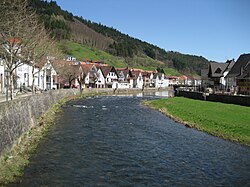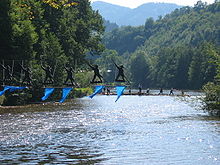This is an old revision of this page, as edited by Philippe (talk | contribs) at 04:11, 27 May 2007 (clean up using AWB). The present address (URL) is a permanent link to this revision, which may differ significantly from the current revision.
Revision as of 04:11, 27 May 2007 by Philippe (talk | contribs) (clean up using AWB)(diff) ← Previous revision | Latest revision (diff) | Newer revision → (diff)| This article may require copy editing for grammar, style, cohesion, tone, or spelling. You can assist by editing it. (January 2007) (Learn how and when to remove this message) |
| Kinzig | |
|---|---|
 | |
| Physical characteristics | |
| Mouth | Rhine |
| Length | 95 km |
The Kinzig is a river in southwestern Germany, a right tributary of the Rhine. It runs for 95 km from the Black Forest through the Upper Rhine River Plains. The Kinzig valley and secondary valleys constitute the largest system of valleys in the Black Forest. Depending on the definition the Kinzig is either the border between the Northern and Middle Black Forest or part of the Middle Black Forest. It is located entirely inside the State of Baden-Württemberg and its name is supposed to be of Celtic origin.
During the Wisconsin glaciation the Kinzig and the Murg created a common Kinzig-Murg river system.
Course of the river
The origin of the Kinzig is located on the land of the town of Loßburg in the district of Freudenstadt. At first it runs south and then makes a gradual turn to the West. It leaves the district of Freudenstadt right after it emerges from Alpirsbach, touches the district of Rottweil and continues to spend the largest part of its course in the district of Ortenau. The Kinzig leaves the Black Forest near Offenburg and merges into the Rhine near Kehl. In its upper part the Kinzig is a true mountain river that over time has caused quite a few serious floods. In its middle and lower parts it has been squeezed into a straight river bed lined with tall levees. Renaturation is in process in the area where the Schutter merges into the Kinzig.
Name
In 1099 the river was first mentioned in Hauptstaatsarchiv Stuttgart as ad Chinzechun, ad aliam Chinzichun, in 1128 the Staatsarchive Sindelfingenreferred to the river as Kinzicha. In 1539, 1543, 1560, 1620, 1652 and 1654 it was listed as Künzlin, Küntzgen, Kintzg, Kintzgen, Oberkentzgenwüß and Köntzig, respectively, until in 1837 it was referred to for the first time as Kinzig.
According to Adolf Bach and Bruno Boesch there is some argument about whether the name Kinzig can really be traced back to the ad Chinczechun, ad aliam Chinzichun of 1099. Bach points to the usage in the northern Breisgau where Kinzigs describe "paths at the bottom of a canyon through the loess". In Upper Alsace and Graubünden rivers with the word Kinzig in their name usually describe a canyon. Some argue that the name developed from the Celtic kent meaning various kinds of quick movement or from the Lepontic word Centica (Cinti) which means "water".
With all these possibilities we return to Adolf Bach and Bruno Boesch who think these derivations doubtful. In addition we must answer the question of how far the Celts or Pre-Celts had settled the Kinzig area and which settlers had originally given the river its name. While these questions are difficult to answer for pre-historic times, fact is that the Kinzig only created a small canyon in its upper part. A completely different river with many twists and turns presents itself as it moves towards the Upper Rhine River Plains. At the end of the last Ice Age it wound its way through the Plains for a long time, on the way absorbing the Murg and only joining the Rhine after it reached the general area of Hockenheim.
Tributaries
The following rivers flow into the Kinzig:
The rafting profession

The Kinzig has had great significance for rafters. The earliest mention of this profession was recorded in 1339. The last commercial raft navigated the Kinzig in 1896. To this day though rafters' festivals, rafting museums in Gengenbach and Wolfach, as well as numerous constructions such as dams remind of those times.
Fauna
A regeneration program has attempted since 2002 to re-introduce salmon into the Kinzig by introducing young salmon and removing obstacles. These efforts seem to be successful as in early 2005, for the first time in 50 years, salmon spawn was found in a river in Baden-Württemberg.
Infrastructure
The width, length and favorable east-west direction in the middle and lower valley make the Kinzig valley important for infrastructure. Already the Romans maintained a road that traversed the valley: The Kinzigtalstraße was a military road built under Emperor Vespasian in 73/74 from Offenburg through the Kinzig valley into the Roman Rottweil (Arae Flaviae) and on to Tuttlingen. The main purpose of the road was to shorten the strategically important connection between Mainz and Augsburg. Until this road through the Kinzig valley was built the connection took troops via the Rhine bend at Basel and during the revolt of the Batavers in 69/70 this had proved to be a problem. During construction of the road several Castelles were built: In addition to Rottweil the rest areas in Offenburg-Rammersweier, Offenburg-Zunsweier, Waldmössingen, Sulz, Geislingen-Häsenbühl augmented by, as part of the Alblimes the fortifications in Frittlingen, Lautlingen and Burladingen-Hausen. All of them were located in Upper Germanic country except for Burladingen which was located in Rhaetian territory. The surprising discovery of the fortification in Frittlingen in 1992 only a few kilometers southeast of Rottweil shows that the Kinzigtalstraße was secured and covered with a tight net of military fortifications. The suggestion that in valley of the Kinzig itself another was home to another fortification has thus gained credibility. Until then, it was supposed that there must have been one or two more yet to be discovered fortifications merely on the basis that the distance between the known ones in Offenburg and Waldmössingen was very big. Another fortification is assumed in Rottenburg by the end of the 1st century however it is not clear whether it existed as early as 73/74 or not until later in 98.
Roughly at the same time that the Kinzigtalstraße was built Roman forts were constructed further north on the right side of the Rhine in places like Frankfurt, Heddernheim, Karben, Groß-Gerau, Gernsheim, Ladenburg (Lopodunum), Heidelberg and Baden-Baden (Aquae). Whether these were advanced posts or whether the Roman border between 73 and 98 already followed a generally defined line east of the Rhine has not yet been determined.
Presumably from the year 98 on the area of present day Southwest Germany to the Odenwald and Neckar came under Roman control making the connection from Mainz to Augsburg shorter yet. As a result, the Kinzigtalstraße lost superregional significance.
In present day Germany federal highway B 33 runs parallel to the Kinzig from Offenburg on until it leaves the Kinzig in the upper valley to follow the Gutach towards Villingen-Schwenningen. From Hausach on towards Freudenstadt federal highway B 294 follows the upper Kinzig.
For the Schwarzwaldbahn train service the valley is also very important. It runs from Offenburg to Hausach where it turns into the Gutach valley to continue on to Konstanz at the Bodensee. In the upper Kinzig valley the Kinzigtalbahn provides a connection between Hausach and Freudenstadt.

Towns along the Kinzig
(starting at the origin)
References
- Emil Imm (Hrsg.) - Land um Kinzig und Rench, Rombach-Verlag (1974)
- Kurt Klein - Leben am Fluss, Schwarzwald-Verlag (2002)
- STALF, A. (1932): Korrektion und Unterhaltung der Kinzig. Die Ortenau 19. pp 124-144.
- NEUWERCK, A. (1986): Der Lachsfang in der Kinzig. Die Ortenau 66. pp 499-525.
- Bach, Adolf, Deutsche Namenkunde, Bd. II/2, Heidelberg 1981
- Bahlow, Hans, Deutschlands geographische Namenwelt, Frankfurt 1985, p. 263
- Boesch, Bruno, Kleine Schriften zur Namenforschung, Heidelberg 1981
- Buck, M. R., Oberdeutsches Flurnamenbuch, Stuttgart 1880, p. 130
- Keinath, Walther, Orts- und Flurnamen in Württemberg, Stuttgart 1951
- Krahe, Hans, Unsere ältesten Flussnamen, Wiesbaden 1964
- Obermüller, Wilhelm, Deutsch – Keltisches Wörterbuch, 1872, Reprint-Druck, Vaduz 1993, Bd. II, pp 178f
- Springer, Otto, Die Flussnamen Württembergs und Badens, Stuttgart 1930, pp 53, 60
- Traub, Ludwig, Württembergische Flußnamen aus vorgeschichtlicher Zeit in ihrer Bedeutung für die einheimische Frühgeschichte, in: Württembergische Vierteljahrshefte für Landesgeschichte, XXXIV. Jahrgang, 1928, Stuttgart 1929, p. 16
External links
- Tourism site of the Kinzig Valley communities
- Rafters' Museum Gengenbach
- Template:De icon History of Rafting in Schiltach
- Template:De icon Information about and images
